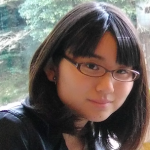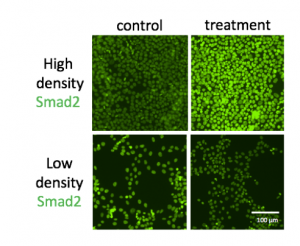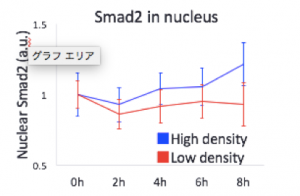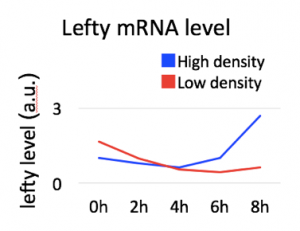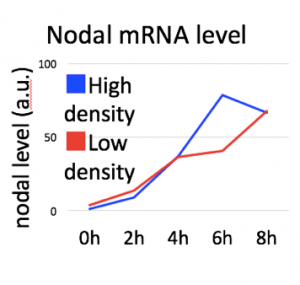Home University: The University of Tokyo
Field of Study: Applied Biological Chemistry and Biotechnology
Status: B3 Expected Graduation: March 2019
Research Host Lab: Prof. Aryeh Warmflash, Department of Biosciences
Why Nakatani RIES?
I am a 3rd year undergraduate student and, as of yet, have little knowledge and experience. Therefore, my future dreams and goals can change drastically, but my current career goal is to be a scientist unveiling the detailed mechanism of cell development. I am thinking of studying for my Ph.D. in America. I expect the internship project to show me the pros and cons of being a scientist in the United States. Professors who had been to the U.S. when they were young said it was definitely a wonderful experience, but it was also really tough. Admittedly, their stories made me feel scared about studying abroad, but I wish to know the experience for myself. If I could enjoy this internship fully, I will gain the self-confidence I need to apply for Graduate Schools in America.
Goals for the Summer
- Conduct some problem-solving experiments in a high-level laboratory. Improve my experimental skills and methodology for thinking scientifically.
- See how my most interested scientific field can be applied in American or world-wide society. Feel what is expected or demanded for from society. Get ideas for generating scientific problems or research theme to research in my future.
- See how research is carried out in the America and compare with that in Japan to decide where to do research in the future. Get used to working as a lab member (as opposed to doing individual research) and cooperating with others.
- Make friends with people who love biology. Also broaden my view by integrating myself into highly multicultural environment of Rice University.
Excerpts from Miki’s Weekly Reports
- Week 01: Arrival in the U.S.
- Week 02: First Week in My Research Lab at Rice
- Week 03: Interview with a U.S. Researcher
- Week 04: Reflections on English Language & Life in the U.S.
- Week 05: Research in the U.S. vs. Research in Japan
- Week 06: Final Week at Rice & Research Poster Presentation
- Week 07: Visit to Washington, DC & New York City
- Final Report & Tips for Future Participants
Week 01: Arrival in the U.S.
Before our departure for Houston, there was an opening ceremony for this program in Tokyo. First, Prof. Shinichi Nishikawa, who was an advisor of Biohistory Research hall and a NPO AASJ, told us his belief of what life science will be in the 21st century. He had extremely wide knowledge of science history and was very good at proposing questions. Although I did not totally agree with his idea, I was so impressed by his way of thinking. The two hours lecture passed quickly, but it showed me how intelligent he was on this topic. Though I enjoyed his lecture very much, I could not help worrying about my future at the same time; how much should I devote my life to studying and researching to be a scientist like him in a few decades? Am I talented enough to set my mind on becoming a scientist?
The second speaker was Prof. Yoshichika Iida, who taught carrier management in Hokkaido University. His lecture was so meaningful to me. He showed us how much Japanese post-docs, assistant professors, associate professors, and professors earn every year in Japan. To be honest, I have trouble earning enough money to live by myself in Tokyo, where the rents for houses are really high, and paying for my school fees even now. I am borrowing money and will have to discharge my debts in the future. How much I can earn as a scientist is a one of my biggest issues. Prof. Yoshichika cited the number from NISTEP Report, which I felt was a reliable resource. From the economic point of view, studying abroad to take a Ph.D. seemed more attractive than studying in Japanese university to me.
What surprised me when I got on the board to Houston was the low-temperature in the plane. Although Sarah and the American fellows had warned me that it was really cold inside in America, it was far beyond my expectation. I did not bring my coat on the plane, so it was so freezing. It seemed everybody in the plane was uncomfortable because of the cold, so I had no idea why they let the air conditioner work so hard.
When I arrived in Houston, I could see the pretty wide sky which we were never able to see in Tokyo. There were no mountains or tall buildings near the airport, so nothing interfered with our sights and the road was straight. The weather in Houston was not as hot as I had expected but it was as humid as in Kyoto. Also, the sunshine was stronger than in Japan. I appreciated that American fellows had recommended me to bring sunglasses to Houston. From a distance, the downtown of Houston looked like Shinjuku in Tokyo. The environment near the hotel and the university looked safer and cleaner than my anticipation, which brought me great relief.
The orientation started on Wednesday. We visited the Office of International Students & Scholars (OISS) to check-in. They gave us a seminar about insurance and also gave us some helpful information of Rice University students’ life. One of the Rice students showed us the campus; the campus was by far larger than my university. Though Rice University is not considered to have a big campus in America. On the next day, we attended lab safety training, which were quite similar to what I had in my university in the past. I found that the disposal rule was far stricter in Japan than in America. Prof. Kono gave us a seminar on researchers’ life in America in the afternoon. He explained about how to get Ph.D. in America and also about the tenure system. I was so interested in his lecture. I did not know much about U.S. green card and visas, so it had never occurred to me that I might have trouble to get a job in America after I earned Ph.D. This lecture helped me understand the details of what should I do if I decide to do research in America. It enhanced my intention to get a Ph.D. in America. Sarah told about her life and the cultural differences between Japan and America in her lecture. I know that it would be better to appeal my skills or talents to others in America, but I cannot like the idea. Being a typical Japanese, I do not like the person who showing off what they can. I guess I need more time to find the way to compromise…

My first weekend was so exciting; I watched a major league baseball game! Actually, I am terribly bad at sports and not interested in them. Therefore, I had never seen any sport games in my life even on TV. However, I said yes when other fellows asked me to watch a baseball game with them: Houston Astros vs. Oakland Athletics. To be honest, I had not expected that I would enjoy the game. Thanks to my kind and knowledgeable friends, I did not have any trouble following what was going on during the game (even though I had not known the number of players in a baseball team beforehand!) In addition, the audience was not as loud as I imagined, which made me comfortable. A friend of mine told me that Japanese audiences support their teams by singing but it is not the case with Americans. I brought scientific papers providing for getting bored, but I need not have done it. When a player of Houston Astros hit an amazing homerun, the crowd’s excitement was almost indescribable. I definitely should watch more games in America!
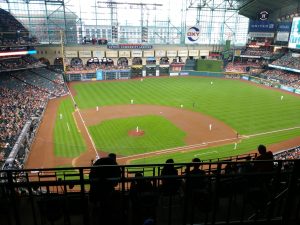
Preparing for Research in the U.S.
While I was in Japan, I contacted my Professor and assigned mentor via email. Prof. Warmflash gave me a quick and kind response to each of my emails, which made me very relived. He sent me some papers that I should read and recommended a textbook to study with. My mentor, Sapna was so nice to me too. She came from India. She advised me which paper to read first and which later, so that I could easily understand the essence. They said that it is normal for undergraduate students to have trouble to understand what was written in a paper, so I should not be ashamed of myself if I failed to understand the contents. They suggested that I just write down my questions so that they could teach me after my arrival.
I tried to read the papers I had given before I arrived in Houston, but it was really hard. They were review papers of hESCs research. There were plenty of technical terms and unfamiliar proteins’ names. Dictionaries did not have the translation of them. I took many notes in Japanese to understand the papers. After I came to Houston, I strongly regretted not to bring a Japanese textbook for my research. Actually, my research field in this program was different from what I was learning at my university. Therefore, I did not have enough fundamental knowledge of my research field. It would be much easier for me if I study it using well-ordered textbook written in my mother tongue. Also, I wished that I had borrowed one of the famous textbooks in the field which was written in English and translated in Japanese. It must have taken less time to identify the meaning of technical terms if I compare them.
My research field in this program is developmental biology. My lab use hESCs to mimic and unravel the early development of human embryo. I will try to discover the effect of Wnt, a protein, for stem cells’ differentiation. The research topic was given when I visited the lab for the first time.
Question of the Week
Do Americans worry about global warming or too much energy consumption? Why they let air conditioners work so hard and wear sweaters to avoid the cold?
- This is a common question for many Japanese students. In terms of global warming, there are actually a lot of Americans that don’t believe this is happening. Or, if it is happening, that anything they can do individually will change it.
- Changing behaviors in the U.S. is difficult so the government often focuses on legislating companies to reduce emissions. So, for example improvements in fuel-efficiency for cars, requiring new appliances (including air conditioners) to be more energy efficient, and trying to limit the emissions of manufacturers or other companies.
- In building in the U.S. there is also greater emphasis on obtaining LEED certification and Rice University has made a commitment that all new buildings on campus will be LEED certified. For more see Sustainability at Rice.
- However, it is those small, behavioral changes that can make the most difference. Turning up the air conditioner or turning the heat down. Shutting the lights off when you leave a room. Most Americans do this at home, because they have to pay the energy bill individual but in the workplace or public building we often do not have this option.
- Look around your office or lab, do you have control of the A/C or heat? Or is the thermostat locked and the temperature can only be changed by the central building control? This is quite common and since most central building controls are operated by men (who typically think it is hotter indoors than women) this means that the A/C might feel too cold to some in the building but just the right temperature to other people in the building. Also, many public spaces keep the A/C on high because it is believed to limit the transmission of germs or can help keep food fresh longer in grocery stores.
- Often, the only option we have is to bring a sweater with us where ever we go if we are someone who often finds buildings cold. But if you look around, you’ll see lots of other people walking with short-sleeves or shorts because they aren’t cold and love the high A/C. It’s not until Americans visit other countries where A/C is not so heavy/high that they realize how silly/odd it is that buildings are so cold in the U.S.
- This can be an example of simply not knowing or being aware that things could be different because all our lives, every public building or office building we go into we just accept it as being normal that it is freezing cold.
- For more on these topics see:
- Google Search: Global Warming in the U.S.
- Why are Offices so Cold? 6 Reasons Companies Need to Turn Down the A/C
- Enduring Summer’s Deep Freeze
- Office Air Conditioning is Too Cold, Women Think, and Science Agrees
Week 02: First Week in My Research Lab at Rice
I met my mentor, Sapna in Prof. Warmflash’s lab for the first time on Thursday, August 17. She explained the theme of her research and our possible schedule for my research project and homework. She suggested that I read a paper per week so that I could better grasp the background and the current tendencies of the field. Then I had the opportunity to say hello to the other lab members, although only a few people were there because the new semester had not begun yet. I was surprised to notice that people in the same lab were working in different rooms. They shared experiment spaces of course, but each office room had only three or four desks and the door was closed. I had expected that American laboratories were more open-concept with everyone in a big wall-less office room. Also, there were boards between the desks, so that they could concentrate on their job. It looked nice to me because I prefer to have my personal space and solo time. I found that there was a big conference room next to the office rooms. I guessed lab meetings could be held in that room. After the brief introduction, we started our experiment. Our first step was changing media of cells. I had done a similar thing in my university before, but it was little bit confusing when I did it in an unfamiliar environment.
My mentor was so kind and very nice to me. The paper she and my professor had recommended me to read through while I was in Japan had been too difficult for me and it had taken a lot of time to understand. However, Sapna gave a commentary on it and also answered many of the questions I had in a very simple way. It was so illuminating and helpful. Sapna took three-day-off to travel to see the total eclipse. Anastasiia, a post-doc in the lab took care of me while she was absent.
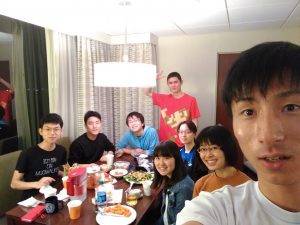
I was surprised to notice how little opportunity I had to speak in English here. Yes, I spoke in English in my lab, in classes and in supermarkets. However, I spent a lot of time with JP fellows at the hotel speaking Japanese. Perhaps just staying in America for five weeks would not improve my speaking skill. I have to do something in order to brush up my English; such as speaking to people who stay at the same hotel, or chatting with other students in the university.
Also, I was too upset and could not talk very well when I met my professor for the first time. It was too terrible that I lost self confidence. I could not talk well partly because I had no experience to explain my ideas for developmental biology in English. I could come up with many ideas in Japanese and I knew some technical terms, but it was difficult to say them correctly in English. I was too embarrassed to be unable to answer his questions immediately and I got into a panic. I read some papers in English and could understand. I had no difficulty to catch up with the professor’s explanation. However, there was hardly any English-output experience. What I have to do is not only increasing chance to speak in English but also studying hard and being familiar with developmental biology world.
I had a lecture about how to make an effective poster by Dr. Gayle Moran and it made it clear what I am supposed to prepare for the final presentation. I did some research when I was in a high school and have made posters in Japanese. I found that the ideal poster style in America and in Japan were almost the same. The lecture conveyed key points in a forthright manner and was very helpful. I was glad to have a chance to attend the lecture. Also, I had a lecture on “Strategies for Vocabulary Acquisition” by Kyung-Hae Bae, who came from Korea and could speak English, Chinese and French. She suggested that we write down any unfamiliar words when I hear them for the first time and figure out their meaning by looking them up in dictionaries. I thought it was a good strategy, but I found it difficult because I cannot spell the words when I do not know them. Some people in America speak with strong accent, so that it is hard to listen and write down unfamiliar words.
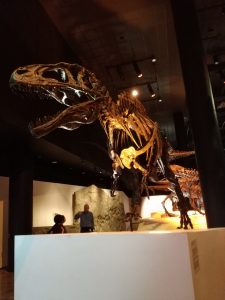
This week, we visited Houston Museum of Natural Sciences (HMNS) as a group. It was one of the most attractive places and I was eager to visit it during my stay in Houston. I love science museums and whenever I am free in Japan, I visit them. It was little disappointing because there was no exhibit on cell biology. However, there were many stuffed animals and zoolites. They were placed in such a sophisticated way and almost looked as if they were living. I was surprised to find there were few exhibitions for kids which they can learn science through practical experiences. Japanese science museums have various such kind of things. For example, children can see and learn that heavy metal and light wood reach at floor at the same time when they drop them at the same time. I guess the HMNS is made for adults, not for kids.
- HMNS does have a robust Education program and in the basement and upper floors there are many classrooms for hands-on workshops, classes, and summer campus for children. Check out their Education page for more details.
- You may also want to visit the nearby Health Museum where you will find more bio-related exhibits. There is also a Children’s Museum nearby that has lots of hands-on exhibits and activities for kids too. That might also be fun to visit.

Research Project Overview
Human embryonic stem cells (hESCs) represent a good in vitro model to investigate signaling pathways active during early embryonic development. Wnt and Nodal signaling are two important signaling pathways that can be modulated to differentiate pluripotent stem cells towards mesendodermal fates. Although the pathway components are well known, the underlying parameters that influence the signaling dynamics are largely unknown. In this project, we will study the effect of cell density on Nodal signaling in response to Wnt signaling.
It is known that Nodal is a direct target of Wnt signaling. When Wnt binds to the receptor, it leads to nuclear localization of β-catenin, a transcription factor. Nuclearβ-catenin enhances the gene expression of Nodal. Nodal is a secretory protein that also activates its signaling by binding to its receptors. Active Nodal signaling leads to phosphorylation of Smad2. Phosphorylated Smad2 moves to the nucleus and also enhances gene expression of Nodal. We will use nuclear Smad2 levels as an indicator of active Nodal signaling.
We hypothesize that high cell density will activate secondary Nodal signaling in response to active Wnt signaling. We think that higher cell density will lead to higher local concentration of Nodal proteins around the cells, which will be sufficient to activate Nodal signaling. In contrast to this, in the low cell density case, Nodal proteins produced by the cells will get diffused out in the media, leading to a very low local concentration of Nodal proteins around the cells. Hence there will not be any Nodal signaling. In other words, we will see nuclear Smad2 in the high-density sample and not in the low-density sample.
To test this hypothesis, we designed an experiment. The experimental details are as follows:
First, we cultured hESCS to get enough number of cells. Then we isolated the colonies into single cells and counted the number. We seeded about 150000 cells in the dishes for “high-density” case, and 15000 cells for “low-density” cases.
We prepared 4 dishes – 2 for high-density and 2 for low-density. We added Wnt protein (300ng/ml) to one dish of each density for experiment and added PBS to another dish as control. We fixed the cells 8 hours after the treatment.
We will perform immunostaining to check for nuclear Smad2. For immunostaining, we will first add the primary antibody, which is from mouse and binds specifically to Smad2. After that, we will add Secondary antibodies that bind specifically to mouse antibodies. As the secondary antibody is bound to a fluorescent protein, we can see the localization of Smad2 by looking the fluorescence-using microscope.
After immunostaining, we will image the samples. If the experiment goes well, then we will do another experiment to figure out more about the timescale of signaling. I will write about that in later report.
We will use MATLAB image-analyzing software to analyze our results. As I have never used the software and I am not familiar with programming, my mentor will analyze the results on my behalf. But I am taking a class to learn MATLAB, a useful software for biological researchers. The class and the homework is little bit tough for me, but I am enjoying it.
Question of the Week
How do ordinary Americans, whose major is not biology, conceive of embryonic stem (ES) cell research from an ethical point of view? Is it awful?
- In the U.S., many people who are religious/observant Christians may have objections to stem-cell research due to moral reasons. However, I think most people in the U.S. don’t really understand what stem-cells are and or have a clear understanding of how this research is beneficial. You may want to speak with people in your lab about this question as they probably could give you other insights/perspectives as well.
- This is an example of where writing ‘research papers’ doesn’t really help the general public understand the topic very well. So, the role of researchers/scientists as public diplomats is important to become a bridge between the technical research of stem-cells and the real-world applications/impact/benefit of this research on the lives of everyday Americans.
- For example, at Rice’s Baker Institute for Public Policy they have produced a series of reports and seminars on stem-cell research. These are often targeted to the general public and highlight some of the political, religious, societal complications of various types of research. You can search their Research Library for ‘Stem Cells’ to see more about their work.
- Here are some other articles on this topic you may want to read but talk with people in your lab too about this question. They may have other perspectives.
Week 03: Interview with a U.S. Researcher
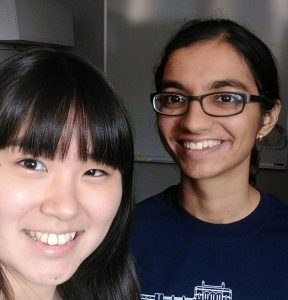
I interviewed my mentor, Sapna, about her research career.
Q: Could you explain about your current program?
I am doing a PhD in System Synthetic and Physical Biology, which is basically an interdisciplinary program in biology. System Synthetic and Physical Biology basically comprises studying the physical principles underlying biological systems. It involves mathematical modeling, quantitative imaging and lot of programming along with usual experimental biology part. Synthetic biology is about creating synthetic biological systems. It is basically more on the genetic and engineering rather than on the biophysics, like you spend most of your time cloning, making fancy genetic circuits, either for better understanding of the biological circuits functions, or creating a new system. Engineering E.coli to act as a probiotic could be one example. Physical and system biology involves studying the physical principles underlying natural systems, like I am doing right now; studying what causes or the principle underlies gastrulation.
Q: Why did you decide to study at Rice University?
I applied to the program because I wanted to study synthetic biology. I was really excited by the fact that I can create fancy genetic systems. There were not a lot of programs or universities offering PhD synthetic biology and Rice was one of the few. And there were a lot of labs at Rice whose research I found interesting.
Q: When did you decide on your lab?
We have three lab rotations during the first semester, each rotation was one-month long. And after three rotations you must decide the lab. In my case, or let’s say in our batch, there were nine students and all of us had very similar interests, so we all rotated in the same labs. At the end of it, all of us chose the same labs. So not everyone could enter the lab they wanted because the spots were limited and the funding was also limited. I was asked to do the 4th rotation. And that was when I came to Prof. Warmflash to ask for a rotation. I was not originally interested in his lab. It was more like I was scared to come to his lab because he was a physicist and I did not think my physics background was good not enough for the kind of work he was doing. But my program coordinator suggested that I try this lab and so I came and spoke to him. He seemed to very nice and friendly and he said let’s start working and we will see where it goes. After working his lab 2weeks, I really enjoyed the fact that I could combine programming and an experimental approach together. That was not something I originally came here for, but it was something which seemed interesting so I chose to stay.
Q: What did you study when you were undergraduate?
My degree was biotechnology and it was a very interdisciplinary program like we did some courses of programming, we did some math, we did some biology. There was a lot of of biology but the biology I studied was mostly microbiology and molecular biology, biochemistry … standard biology stuffs. We never study developmental biology, so this was very new to me.
Q: What is like to be a researcher in the U.S. compared to in your home country?
In my home country, India, the resources were limited. You must be extra careful about your experiments and your spending. Another thing is the field is not as diverse as you have here. The freedom to do what you want to or the freedom to take in a different direction is more here but I think that depends on your lab atmosphere and lab Principal Investigator (PI) a lot. So, I do not think that’s is a U.S. vs India difference as much as a PI vs a PI difference.
Q: What will you do after completing your PhD?
I want to do a post-doc. I eventually want to go back to research/teaching in India because my family is there and I see a need to contribute to science back in India.
Q: What is your nature of your work environment?
There is no core-time in the lab. It is very flexible. If my project is progressing and I am working, I think everyone is fine with the timing. Though, you must attend the lab meeting and you cannot miss the free meeting with Dr. Warmflash; you must update your project every week.
Q: Do you have any experience of doing research in other labs?
I did two internships outside India. One was in Heidelberg in Germany, and the other one was in Cambridge in U.K. I went U.K in 2014 Jan-May and Heidelberg was one year before that. I did them during my summer off. In Heidelberg, the lab was small and I was directly working with the PI. I did synthetic biology and I found it very interesting. In U.K., I did bioinformatics, which was very different experience from the one in Heidelberg. I found bioinformatics not very interesting and I did notice I prefer small lab to big lab. When it comes to biotechnology field, many Indian people do internship abroad during the summer break.
A question from interviewee
She asked me about my previous lab experience. I did some experiments at labs in my university, so I explained it. I guess she was curious my research back ground just because I asked hers.
Reflections on Interview
I was surprised to hear that many Indian students do internships abroad during summer vacation. I knew that many undergraduates in European countries are encouraged to do internship abroad, but I had no idea about India. Sadly, summer break in Japanese universities is much shorter than theirs. In addition to this, the month when the new semester begins is different from that in other countries. I am very lucky to have an opportunity to do internship in America. Although there are many undergraduates who go abroad to study English or to take some classes in a foreign university, there are few chances to do research internship abroad for Japanese students. I believe most of the Japanese in 1st-3rd year do not have any experience of doing problem-solving experiments even in Japan. I do not think it is good. I want Japanese government to make more opportunities to do research for younger generation.
Research Project Update

As I wrote in previous report, we are investigating the effect of cell density on Nodal signaling. To this end, we added Wnt to stem cells to start the experiment, fixed the samples after 8hrs and stained for Smad2.
Sadly, many cells died during the hurricane. We said good-bye to the old dishes adding disinfectant. We got new cells by thawing frozen cells and waited till they grew to the ideal number. We already fixed some dishes before the hurricane came, and we decided to use them for our research. We stained for Smad2 using the immunostaining protocol that I explained in the previous report.
We then imaged our samples. Qualitatively, we could see the difference between the high-density case and the low-density treatment samples. In high-density sample, we could find the three different regions: regions where Smad2 was localized in nucleus, regions where Smad2 was spread in cytosol and nucleus, and the areas where Smad2 was absent from the nuclei. In the low-density treatment sample, Smad2 seemed to be just localized in nucleus in a few cells. We will analyze the images quantitatively to make a conclusion.
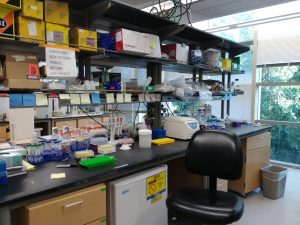
As we could see the differences between high-density and low-density samples, we have decided our next step; we will study the dynamics of see Nodal and Lefty transcription, and Nodal signaling. Lefty is an antagonist of Nodal. We expect that there was Lefty in the areas we did not see the nuclear localization of Smad2.
We will repeat the similar experiment, but this time, we will prepare 10 dishes – 5 for high-density and 5 for low-density. We will add Wnt at the same time to all the dishes, but will fix them at different times – 0h(control), 2h, 4h, 6h, 8h after the treatment to see how Nodal , Lefty transcription and smad2 localization varies in time.
Then we will do single molecule fluorescent in situ hybridization (smFISH). FISH is a major technique to see mRNA in a microscope. It involves adding a probe, complementary to the Nodal, Lefty mRNA. The probe will hybridize with the target mRNA. The probe-mRNA hybrid goes through a series of amplifications. The last amplification reagent contains a flurophore which enable us to see the target mRNA using fluorescence microscope. Our target is Nodal and Lefty, so we will add two probes to bind the mRNAs.
After FISH, we will stain Smad2 in the same way we did and do imaging and analysis.
I think our experiment is going well so far. I am looking forward to seeing the images of our cells.
Question of the Week
It it normal for a highly-motivated American to do a research internship during the summer break, too? If the answer is yes, then where they will go to research; go abroad, or just do in your own university, or go to different university or institute for a short time?
- Yes, this is very, very common; especially for students in STEM fields. Because of their course requirements, it can be difficult for STEM majors to study abroad during the semester or academic year so they often look for opportunities to study abroad or do research abroad in the summer.
- For example, for the 2017 Nakatani RIES Fellowship for U.S. students we received a total of 141 applications and only 12 students were selected. This shows how popular these types of international research programs are and how competitive it is for U.S. students to get in.
- For more on this see:
- Doing Research: Undergraduate Research in Japan vs. the U.S.
- Other Related Opportunities for U.S. Students (check out the wide array of programs/opportunities they can apply to at both the undergraduate and graduate level)
Week 04: Reflections on English Language & Life in the U.S.
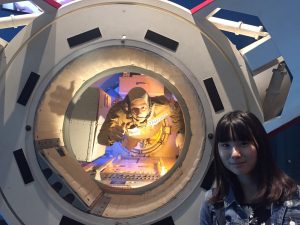
After spending four weeks in the U.S., I began to admit that my English skills are not as good as those of other foreign students at Rice. At first, I hoped that my speaking skills would improve as I got used to the English-speaking environment, but it did not. I have not studied English for two years and my vocabulary faded away. Although I know many words and I can say the meaning of them, they do not come up to my mind when I need them. I noticed that I have had hardly any opportunity to communicate in English in Japan. It has affected me more than I had expected. When I was a high school student, I loved speaking English and was willing to speak in English. However, it became a little bit tough for me now. I guess that is partly because the objects of talking are getting more and more complicated and sensitive. I noticed that I should speak more slowly that I can speak with more accuracy. This is not a test which requires me to talk as much as I can in a limited period. I also know that what I am lacking most is confidence. After all, they will get what I am trying to say even if my grammar is not good. I have to speak a lot to be good at it. Practice makes perfect.
Writing about my research takes more time and effort. I do not know many technical terms. In addition to this, even when I know the term, I do not know which preposition is suitable for it. When I asked my mentor to check my weekly report, she pointed out many mistakes. I was disappointed because I had prepared very carefully and had not expected that I made that much mistakes.
- Technical writing is difficult for many students, both American and international. This is why most universities have developed various programs/centers that help students with their writing skills and that you can access for free if you are a student there.
- At Rice, some of these programs include:
- Program in Writing & Communication
- Center for Written, Oral, and Visual Communication
- Rice Center for Engineering Leadership: Communication Support
- Dr. Moran also has developed a number of online courses through Coursera including “Writing Skills for Engineering Leaders”, “Oral Communication for Engineering Leaders”, and “Interpersonal Communication for Engineering Leaders”.

Although my writing skill is still terrible, my listening skills are getting better. I have gotten used to listening to English with Indian accent because my mentor is from India. As America has an extraordinary diversity of people, I have had difficulty understanding what people say with unfamiliar accents. Now that I have gotten used to them and can more easily comprehend what they are aiming at. On the contrary, I found it difficult to catch native English speakers’ words because they speak very fast. Moreover, some American students use too much slang so I cannot follow them. I guess I need to speak to young Americans more.
I am trying to speak to the people who I meet in the elevator or on the hotel/school bus to improve my English skills. I appreciate this custom in Texas. Everybody who I have spoken to was kind and friendly. However, I desperately need a friend who can speak frankly and deeply without getting nervous. The Rice American fellows are nice to us, of course. They often come to our hotel to see us. My mentor and other Ph.D. students are nice and friendly, too. However, I have not made any new ‘friend’ in America so far. I could not join a badminton club activity due to the hurricane. I failed to attend the lunch with American students who study Japanese because I had to care for the cell at the time. I will try to make a new friend during the stay. I want to exchange ideas about research, beliefs, and hope for our future with her/him.
Research Project Update
This was our research plan for the week. First, we would image the samples we prepared last week and analyze them. Second, we would repeat exactly the same experiment to confirm that the result is reproducible. Third, I would start making my poster.

My mentor, Sapna tried to explain to me how to use a microscope in the microscope room. However, ten to fifteen minutes after entering the room, I felt giddy and I could not see things well. Also, I could not hear her voice as if I were in the water. I guess it was partly because the room was hot and ill ventilated, and partly because I had not had substantial meals in those days. I had been too busy to cook, so I had eaten cereal, pizza, and such kind of foods mostly. As I could not keep on imaging, Sapna did on behalf of me. I was bitterly disappointed. I love taking images using a microscope. I really wanted to do whatever I can for the research. Also, I felt guilty for Sapna because imaging the samples took many hours. I went back to the hotel and slept for a few hours, then went to the grocery store to get some highly nutritious food. I cooked Japanese curry, which contained many vegetables and meat for dinner and went to bed early.
The next day, I felt pretty good. I started to reexamination. I counted the number of cells and seeded them as I did before. I was happy to notice that I did better and faster than I had done before. I am getting used to it.
I have not analyzed images yet because I did not have enough time. I could not use MATLAB well, but I can do something using easier soft wares, such as FIJI and ilastik. I look forward to examining the images. There is a deadline for a poster approaching. I have to work hard to submit before the deadline.
Question of the Week
The people in my lab have lunch alone at their desk. Is it common for American researchers? I mean, don’t they get together or hang out for having a lunch?
- Yes, this is often a difference between labs in Japan vs. in the U.S. In Japan, there is more emphasis on group culture/dynamics so it is very common for everyone to go have lunch together at the same time. This is also easier in Japan because everyone is usually working in the same office/room so you can all leave together. In the U.S., many people eat lunch at their desks and use that time to catch up on email, surf the web, read research articles. In this sense, lunch is still a time to ‘get things done’ rather than a time to connect with all group members. However, it’s not uncommon for a few people who are friends to go to lunch together.
- At the BRC I think it is hard because you can’t easily walk to the RMC/Student Center or other spots on campus to have lunch together. But if you were to go to the RMC/Student Center at lunch time you would see more groups of graduate students sitting at the tables and eating together. Sometimes, these may be groups of friends from different labs rather than everyone from the same lab. Since many graduate students pack their own lunch to save money, they also often don’t go out to eat together at restaurants every day for lunch as this can comparatively more expensive than in Japan.
- This is one instance where you might have to ‘advocate’ for yourself and ask someone in your lab if they would like to eat lunch with you. For example, if it is a really nice day outside you could say “Wow, the weather outside is so nice. Sapna, would you like to sit outside and have lunch with me today?” She might not be able to today if she is too busy but because you asked her she might be more likely to suggest you go eat lunch together in the future. Even though you are the junior member of the lab you can suggest something like this as, if you wait for others to ask you, you may end up sitting at your desk, eating alone. Asking people if they’d like to eat lunch with you can also be a good way to become better friends with other members of your lab too.
Week 05: Research in the U.S. vs. Research in Japan

It was a good surprise for me that my mentor avoided explaining everything to me, but let me think more about my research project by myself. She was always willing to answer my questions, but she tried not to tell me the answer directly but gave me some hints so that I was escorted to the answer. It was not what I had expected before I came to Houston. When I conducted a research in my university, a Ph.D. student always stood by me to monitor and told me what to do next. I preferred the American style because it was more exciting. I guess that she did this in such a natural way because she was used to taking interactive classes and being taught in the way.
When it comes to my labs internal communication, my lab mates did not seem to interact with each other very much compared to ordinary Japanese labs. They concentrated on their work. Of course, they chatted during the waiting time and there were a lot of small converations. They seemed to be very close, but they did not discuss their research with others so often.
I believe people in America valued the results more than how many hours or how long they work. To the contrary, Japanese people tend to praise those who works hard and devotes a lot of time to research. Our lab used MATLAB, a software, to analyze the data. Computer programming experts need a short time to write a good MATLAB code. However, those who are not good at programming may spend a lot more time to write a less useful code. I guess that is one of the reasons why the people in my lab valued results more than the effort they made. I found that how well one analyzes the data and how well one describes the results was very important in both cultures –Japan and America. No one can be praised when he is unable to tell the importance of the research to others.
Another thing I was surprised by was that some Ph.D. students were determined to build their own companies. They seemed to believe their success. I think they are less worried about their future than Japanese people. They had a solid view and will for their future and believed it would come true. I think most Japanese Ph.D. students look for a job in academia or in the industry, rather than build their own companies (becoming an entrepreneur). That is partly because it is more difficult to build a new company in Japan compared to in America due to cultural differences; Japanese people are more conservative than Americans. I prefer the American atmosphere to the Japanese one because I have more options for the future; though I am not interested in building a company. It must be quite challenging to build a company and run it by oneself, but it would be more exciting. I want to be with people who take such kinds of risks.
After spending five weeks in Houston, I have now decided to pursue a Ph.D. in America after I finish my undergraduate degree. I have come to think that I can manage to live in America. I am sure that it would be tough for me, but I believe I can do it. In addition to this, I prefer the American research environment. The most attractive point to being a Ph.D. student in the US is the lab will pay for my tuition and pay me a stipend if I work as a graduate research assistant. I can concentrate on my experiments and studying. I do not have to do a part-time job to pay my rent. That is wonderful. I realized that I love doing research. I did not get bored at all, even when I must do pipetting for hours. I loved doing experiments much more than going shopping or going sightseeing or playing games. I am sure that I will miss the job-less research weeks after I returned to Japan.
I realized what I am lacking now – I still need to brush up on my English communication skills, widen my vocabulary, and understand the insurance system and visa system in the U.S. to live in America. However, I still have a year to prepare. I will study hard to come back to America.
- See our Applying to Graduate School page.
Final Week in Lab
I did image analysis this week. First, I imported images of Smad2 to FIJI using a plugin called Bio-Formats. To grasp what had happened, I decided to calculate the intensity of fluorescence in nuclei. I chose ten cells randomly per image and got the average. I could see the difference between the low-density samples and high-density samples. Obviously, I needed more data to make a conclusion. I used ilastik to get more data. Ilastik is an image analysis software which can be used for binarization. It identifies where the nucleus and is and where it is not by deep learning. We imported the DAPI images, the images of nuclei, and trained the software telling where was the nucleus and where was the background. I used ilastik for the first time and was surprised its convenience. I want to let my Japanese friends know about this software!
The next step was to open the binary data in MATLAB and calculate the intensity of the fluorescence in a nucleus and get the average. It was too complicated for me, so my mentor did it. I have recognized the importance of computer science skills anew. I should study MATLAB more after returning to Japan.
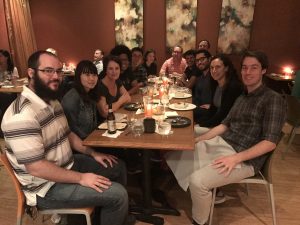
There was a farewell party for Anastasiia, a post-doc in the lab. I was invited to the party and we went to a Japanese restaurant to have dinner. Actually, I did not know some of the lab mates until the party. It was a good chance for me to talk with people in the lab. Some people gave me advice about which universities have good stem cell research. It was helpful. I was happy to know that many foreigners love eating Japanese dishes in America.
After getting the results, I started to make a poster for my presentation. I belonged to a science club when I was in a high school and I was used to making a poster to explain my research. It was fun to combine geometrical figures to make original pictures. Sapna and Prof. Warmflash gave me helpful advice. I enjoyed making my poster very much and it took many hours because I wanted to make a nice poster.
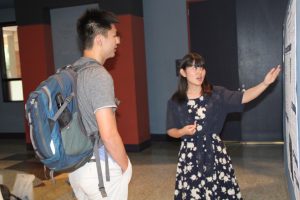
Then, I practiced presentation again and again. I was little disappointed that some Japanese fellows who never studied biology in university did not understand my research at all. However, it was a not biology vs physics matter but a Japanese vs English matter. When I explain about my research in Japanese, they understood. At the poster presentation, many students who did not study biology came to hear my presentation. I was happy because they tried to understand my research when they had no biology background and they DID understand my research. They seemed to notice the importance of developmental biology and stem cell research. It was sad that I could not hear the other students’ presentations, but I really enjoyed explaining. I definitely want to have another chance to present my research!
Question of the Week
Do international students in Ph.D. program send money to their parents? How do they care for their family when their parents get old and retire their jobs?
- As a graduate student, you probably won’t have enough money after paying for your daily living costs to send much money back home to your parents. However, if you stay in the U.S. long-term and get a job then, perhaps, you will be able to do this. Many immigrants to the U.S., at all educational and professional levels, will send money home to support their parents or to help the next generation in their family pursue educational or professional opportunities.
- This varies by person and the specific needs of their family. For example, if your parents have a good retirement plan in their home country you may not need to send as much; but some countries, like Japan, can be very expensive so retirees may still need supplemental funding from their children.
- Balancing family commitments when you live half-way around the world (or even in a different state in the U.S.) can be very hard. We say in the U.S. that this is a situation where “You are pulled in multiple directions”. For your educational and career goals, you may want to be in the U.S. but, at the same time, you have guilt or worries about the well-being of your parents or family in Japan.
- This is not easy to navigate and each person had to find their own individual path that will work best. Many people who live in the U.S. make plans and save money to return home for extended visits to family during the summer or winter break each year Of course, this is not the same as living nearby and being able to be a part of their day-to-day lives and this is one of the biggest trade-offs of moving away from family and friends.
Week 06: Final Week at Rice & Research Poster Presentation
After the poster presentation, we went to have a last dinner in Houston at a nice restaurant. We ate lobster and shrimp. I was about to cry because I was too sad to leave Houston. I was so excited to conduct the experiment. I already began to miss my lab. The restaurant was little far from the hotel, so it was around 11 p.m. when we got back to the hotel. We were surprised that Jakob and Savannah came to say goodbye to us with a lot of doughnuts! We appreciated their kindness and were thankful for having a chance to say goodbye to them.
It was around 2:30 a.m. when I finished packing my suitcase. We took a few hours nap and went to the airport to go to Philadelphia at 5:30 a.m.
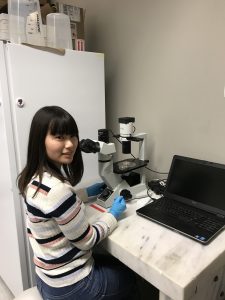
Research Project: “Effect of Cell Density on Wnt-induced Nodal signaling in Human Embryonic Stem Cells” (PDF)
Student: Miki Matsumoto
Host Lab: Warmflash Lab, Department of Biosciences, Prof. Aryeh Warmflash, Rice University
Mentor: Sapna Chhabra
Introduction: We used Human embryonic stem cells (hESCs) to investigate human embryonic development. They represent a good in vitro model to investigate signaling pathways active during early embryonic development. Getting images and analyzing them is easier compared to 3D complex embryos. Also, they are specific to human development.
We focused on Wnt and Nodal signaling. They are two important signaling pathways that can be modulated to differentiate pluripotent stem cells towards mesendodermal fates. Although the pathway components are well known, the underlying parameters that influence the signaling dynamics are largely unknown. In this project, we studied the effect of cell density on Nodal signaling in response to Wnt signaling.
It is known that Nodal is a direct target of Wnt signaling. When Wnt binds to the receptor, it leads to nuclear localization of β-catenin, a transcription factor. Nuclear β-catenin enhances the gene expression of Nodal. Nodal is a secretory protein that also activates its signaling by binding to its receptors. Active Nodal signaling leads to phosphorylation of Smad2. Phosphorylated Smad2 moves to the nucleus and also enhances gene expression of Nodal. We used nuclear Smad2 levels as an indicator of active Nodal signaling.
We hypothesized that high cell density would activate secondary Nodal signaling in response to active Wnt signaling. We thought that higher cell density would lead to higher local concentration of Nodal proteins around the cells, which would be sufficient to activate Nodal signaling. In contrast to this, in the low cell density case, Nodal proteins produced by the cells would get diffused out in the media, leading to a very low local concentration of Nodal proteins around the cells. Hence there would not be any Nodal signaling. In other words, we would see nuclear Smad2 in the high-density sample and not in the low-density sample.
Methods TEST1: First, we cultured hESCS to get enough number of cells. Then we isolated the colonies into single cells and counted the number. We seeded about 150000 cells in the dishes for “high-density” case, and 15000 cells for “low-density” cases. We prepared 4 dishes – 2 for high-density and 2 for low-density. We added Wnt protein (300ng/ml) to one dish of each density for experiment and added PBS to another dish as a control. We fixed the cells 8 hours after the treatment.
We performed immunostaining to check for nuclear Smad2. For immunostaining, we first added the primary antibody, which is from mouse and binds specifically to Smad2. After that, we added Secondary antibodies that bind specifically to mouse antibodies. As the secondary antibody is bound to a fluorescent protein, we can see the localization of Smad2 by looking the fluorescence-using microscope. After immunostaining, we imaged the samples and analyzed them using FIJI, ilastik and MATLAB.
Methods TEST2: We repeated the similar experiment, but this time, we prepared 10 dishes – 5 for high-density and 5 for low-density. We added Wnt at the same time to all the dishes, but fixed them at different times – 0h(control), 2h, 4h, 6h, 8h after the treatment to see how Nodal, Lefty transcription and smad2 localization varies in time.
Then we did single molecule fluorescent in situ hybridization (smFISH). FISH is a major technique to see mRNA in a microscope. It involves adding a probe, complementary to the Nodal, Lefty mRNA. The probes hybridize with the target mRNA. The probe-mRNA hybrid goes through a series of amplification. The last amplification reagent contains a fluorophore which enables us to see the target mRNA using fluorescence microscope. Our target is Nodal and Lefty, so we added two probes to bind the mRNAs. After FISH, we stained Smad2 in the same way we did and do imaging and analysis.
Results TEST1: Nuclear Smad2 in high density increased compared to the control, but that in low density remained the same.
Results TEST2: Nodal mRNA level in both samples increased. That in high density samples showed a great increase between 4-6 hours after the treatment, while that in low density gradually grew.
Lefty mRNA level in high density samples increased at 6-8 hours, whereas that in low density samples showed no increase. Similarly, Nuclear Smad2 in high density increased gradually at between 2-8 hours, though that in low density remained the same.
Discussion: Smad2 in the nucleus increased in high density samples and remained the same in low density samples. Also, Lefty mRNA increased only in the high density samples. This implies that secondary Nodal signaling was not activated in low density samples.
Although Nodal is a target gene of both primary Wnt signaling and secondary Nodal signaling, Lefty is a target gene only of the secondary Nodal signaling. Therefore, we could say second-signal-induced transcription occurred at 6-8 hrs after the treatment. Hence, the higher Nodal transcription between 4-6 hrs in the high density samples is due to high Wnt signaling response. This implies that cells in the high density samples respond better to primary Wnt signaling by producing more Nodal proteins, which then lead to higher Nodal signaling.
Further Research: Our results suggest that cells in higher cell density sample respond better to Wnt signaling. We can test this hypothesis in two ways:
- In the same experiment, stain for β-Catenin at different time points.
- Perform the same experiment in the presence of an inhibitor of Nodal signaling.
Conclusion: We concluded that cell density affects Wnt-induced Nodal signali
Return to Top
Week 07: Visit to Washington D.C. and New York City
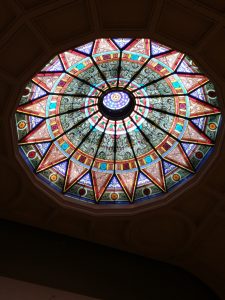
Usually, I go to bed at 10:00 p.m. and get up from 5 to 6 a.m. However, I had been stayed up late the past few days to prepare for the poster presentation. In addition to this, I was exhausted due to the presentation and packing and slept for only 3 hours. When we arrived in Philadelphia, we headed to Reading Terminal Market to have lunch and visited a museum of the American Revolution. Actually, I had a fever then and all I wanted to do was sleep. I believe the other Japanese fellows thought the same thing. Even Sarah and Mr. Ogawa, the program coordinators, looked sick. I really appreciated that they planed a nice schedule to show us the American culture and history, but I could not help seeking chairs to rest that day.
As soon as we arrived at the hotel, I jumped into the bed forgetting to have dinner. The next day, we went to Lehigh University. The campus was so pretty!! It was quite different from Rice University. It is located in a more mountainous area and very quiet. I liked the place. There was a panel discussion with professors at Lehigh University and a special talk with Dr. Kathrin Zippel, the author of “Women in Global Science“. I enjoyed this session very much. I wished I had more time to chat with them.
In the afternoon, we participated the activity of strength finder assessment. To be honest, I did not notice the meaning of the activity before it began. I had had no idea why we would do the activity. However, it turned out to be a very good class! I believe I can use the information I got there when I take any kind of interview. It revealed my strengths that I had not realized. It was so helpful!
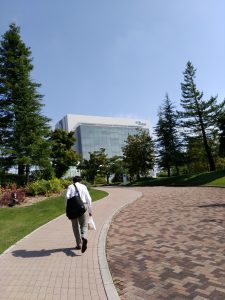
The next day, we flew back to Japan. I was surprised at the room temperature. I was used to the cold rooms in America, so it was very hot to me! We went to Sysmex, a company, to take part in the closing ceremony. I enjoyed explaining my about research to the researchers in Sysmex. I was happy to answer their questions because they asked me what I wanted them to know!
It was sad to say goodbye to other Japanese fellows, but we know that we will get together again someday. It was very nice to meet them!
Question of the Week
What do Americans eat when they are sick? Japanese people usually eat watery cooked rice or udon. I cannot find any stomach-friendly American food.
- We eat the same thing – usually chicken soup! You can find canned soup at the grocery stores or prepared soup in the deli/prepared food section of the grocery store.
- Some people even cook soups from scratch at home and, since American recipes make so much, they will freeze the leftovers in plastic storage bags or containers in their freezer and then defrost to eat when they don’t have time to cook – or when they are sick.
- Tip, while there are not many udon restaurants in the U.S., it is becoming more common to find Ramen restaurants in many cities and these can be good places to eat when you are sick as, sometimes, they serve udon too.
- Another excellent option is Vietnamese Pho. There are tons of Vietnamese restaurants in Houston and pho can be an inexpensive hot soup option when you are feeling sick or the weather is cold.
- Remember, most Americans don’t eat just plain, white rice. So, this would not be a food that many Americans would think of when they are sick with a cold or the flu. However, if you have diarrhea, plain white rice is a recommended food to eat along with bananas, applesauce, and plain toast. This is called the BRAT diet.
- 15 Best Foods to East When You Are Sick
- Exactly What to Eat When You Have a Cold or Flu
- The Best and Worst Foods To Eat When You are Sick
Final Report & Tips for Future Participants
When I came back to Japan, I was very happy that all the dishes I ate was so delicious. After all, I love Japanese food and do not like American food so much. Even a bento which I bought for \300 in a convenience store tasted good. They did not hurt my stomach and were healthy.
However, I realized how I hate the crowdedness of Tokyo. There are too many people on the trains, on roads, in shops…everywhere! About few weeks have passed since I came back to Japan, but still I am irritated about this problem. It is very uncomfortable. What is more, I am not satisfied with the size of my room in Tokyo. I live in a dormitory by myself in Tokyo and the room is too small for me. The room where I stayed for a month in Houston was fifteen times larger than my own room. I miss the big room. I miss the less populated environment.
To my family, I want to say that what I gained during my stay was the confidence to live in America and do research there. I believe I can enjoy American research life. I think I can live in America as healthy as I od in Japan, or healthier when I consider the population of people. I do not feel too lonely when we can contact each other, and I can cook Japanese food in America to stay healthy. I can afford to live in a nice apartment if I get a good scholarship or hired by a university. Therefore, I will try to enter one of the universities in America.
To a professor in my university, I would like to talk about my problem-solving experience. When I was in a high school, I belonged to a natural science club and did some research. We made a plan by ourselves and carried out the experiments and analyzed the results. All the teacher did for us was monitoring us so that we did not get hurt during the experience and giving us a lot of helpful advice. However, at my university, I rarely have that kind of opportunity. I do an experiment as I lectured to by my supervisor and analyze the results by the way they asked us to. I know that it is very important to know how to do the experiment and how to do analysis. I am in the learning course so I should learn many tips for conducting the experiments. In America, however, I did a similar thing to what I had done in a high school. It was so exciting. I just cannot wait to be a senior and do a research by myself at my university.
To my friends who are in the same university, I would like to share the idea that we might be too worried about our future. Most of my friends have a pessimistic view of life. They often complain that they do not want to get a job or they do not have the confidence to get a job. Girls wonder if they will have a chance to have a baby. We talked about how we should feed our parents when they retire their jobs and cannot receive enough pension.
However, students at Rice University were more optimistic. They seemed to believe they can make it. They looked less obsessed with the idea of the negative possibilities for what will happen in the future and less irritated by these thoughts. I do not think they are by far richer than us and it’s not because they do not have the same difficulties we are faced to. However, they take things easily. I think that is nice. We should learn from them. We might have to stop worrying and enjoy our life more.
I have now decided to go abroad to do research. I think this is a big choice for me. To be honest, I did not like “American people” before I go to Houston. They seemed too rude and too self-centered for me. I knew that that is not their fault or mine, neither. I felt the cultural difference was too big and I cannot fit in the American one. However, the people in Houston were very kind and friendly and less aggressive than I had imagined. I did experience some uncomfortable situations, but I could stand them and learn from them. I have noticed that as America is such a large country, the temperament of people is different and diverse. It was good news for me that I can make friends with people in America.
Tips for Future Participants
For the future participants, I would like to recommend to prepare very well for the research by reading paper and books. I think it is easier for us to understand science in Japanese. I suggest that you should read Japanese books related to your field before you leave Japan. There must be many books in the library at your home university about your research field, but it would be difficult to find a good article written in Japanese in America. Also, I strongly recommend to set the goals for the program and write it down so that you will not forget it. Once you arrive in America, you will be busy with research and seminars and may forget the big purpose of participating the program. If you remind yourself of your end goals once in a week, you would be able to maximize the opportunity.
Follow on Project
I have two plans to promote the Nakatani program. One is doing a poster presentation to the students in the Faculty of Agriculture. Another plan is putting up our posters and explanation of this program in the library for freshmen and sophomores.
I will do the poster presentation to Japanese students in Japanese. Actually, the teacher who allowed me to skip some classes in my university in order to take part in the program asked me to do it. I hope some students would cherish some interest in going abroad to do a research.
I will put up the posters in the library because that is the only thing I can do to the students in the 1st and 2nd grade. They go to the different campus from mine and it takes about an hour to get the campus from my campus. I have no chance to talk with them in person. Instead, I came up with this idea. There is a library in the campus and the librarians encourage us to show something to other students in there. There are some showcase and posting boards. We can borrow the space for three weeks to promote the program. I am sure that the library is the only space for the students to study and the students who are interested in going abroad to study must come to the library often. I believe it will work.
Also, I sent some messages to my friends who are the potential participants personally. In fact, I applied for this program because a friend of mine told me about it. I believe the message to a person is more effective than the message to everyone. They will take more time to consider whether to apply when they get a message from a friend.
Final Question
Though the University of Tokyo have been ranked top 30 universities in the world every year, there are few American students came to study in it. What is the biggest reason you do not choose it?
- American students typically do not study abroad as a degree-seeking student at a foreign university. Instead, they may choose to study abroad for a semester or summer while they are enrolled at a U.S. university. Since the American educational system is so strong, most students and parents would not even consider studying at a university in another country for your entire degree.
- Most important though, very few universities in Japan offer undergraduate classes in English and to be able to pass the entrance exam for the University of Tokyo and take undergraduate classes there you would have to speak fluently in Japanese. Since very few American students can fluently speak Japanese, it is not possible for them to do their entire undergraduate degree in Japan.
- At the graduate level, the language classes are offered in remains a problem; though there are more universities in Japan that are offering master’s and PhD programs in English.
- However, for graduate students the primary concern is funding – and in Japan you have to pay for your own tuition fees and don’t receive a stipend for a master’s or PhD program (unless you win special scholarships). So, the U.S. system remains more attractive for science and engineering students because, if you apply to a PhD program, you will most likely join a lab where the professor’s research grants will pay not only your tuition but also give you a stipend for you to work in that lab as a graduate research assistant while you complete your degree.
- So, most of the reason is practicalities – language and funding – though Japan is a very popular destination for U.S. students who want to study abroad for a semester or summer and is currently #10 for the most popular country for U.S. students based on the Institute of International Education’s annual Open Doors report (see the Fast Facts sheet for 2016).
- For more on this, see:
- Education in the U.S. (particularly the section on Internationalization and Study Abroad)
- Why International Research?
- Other Related Programs for U.S. Students (particularly the section on Programs in Japan)
